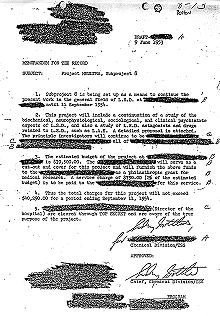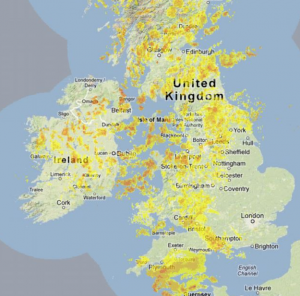 If the terrorists succeed in their evil plan, Britain and the rest of Europe will suffer much worse winter weather than they are still slogging through this spring. The attackers’ effort to cause ecological disaster in the Antarctic will plunge Europe into years of long deadly winters. Can Perry stop them in time?
If the terrorists succeed in their evil plan, Britain and the rest of Europe will suffer much worse winter weather than they are still slogging through this spring. The attackers’ effort to cause ecological disaster in the Antarctic will plunge Europe into years of long deadly winters. Can Perry stop them in time?
The Atlas Fracture on Whizbuzz
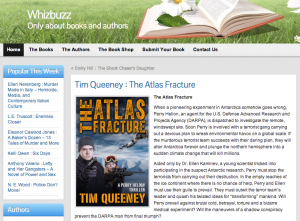 The new Perry Helion thriller has its own page on Whizbuzz! So buzz on over and check it out. You can read the description (or just buy the book!), check out my links and can use a variety of tools to spread the word on social media: FaceBook, Twitter, StumbleUpon, Google+, Pinterest, LinkedIn and Digg.
The new Perry Helion thriller has its own page on Whizbuzz! So buzz on over and check it out. You can read the description (or just buy the book!), check out my links and can use a variety of tools to spread the word on social media: FaceBook, Twitter, StumbleUpon, Google+, Pinterest, LinkedIn and Digg.
Cool.
The Atlas Fracture
When a pioneering experiment in Antarctica somehow goes wrong, Perry Helion, an agent for the U.S. Defense Advanced Research and Projects Agency (DARPA), is dispatched to investigate the remote, windswept site. Soon Perry is involved with a terrorist gang carrying out a devious plan to wreak environmental havoc on a global scale. If the murderous terrorist team succeeds with their daring plan, they will alter Antarctica forever and plunge the northern hemisphere into a sudden climate change that will kill millions.
Aided only by Dr. Ellen Kaminev, a young scientist tricked into participating in the suspect Antarctic research, Perry must stop the terrorists from carrying out their destruction. In the empty reaches of the ice continent where there is no chance of help, Perry and Ellen must use their guile to prevail. They must outwit the terror team’s leader and quash his twisted ideas for “transforming” mankind. Will Perry prevail against brutal cold, betrayal, torture and a bizarre medical experiment? Will the maneuvers of a shadow conspiracy prevent the DARPA man from final triumph?
MK Ultra
The CIA program referred to in my latest thriller, The Atlas Fracture, as “MK Ultra” did exist. It was, according to Wikipedia, “…the code name of a U.S. Government covert research operation experimenting in the behavioral engineering of humans (mind control) through the CIA’s Scientific Intelligence Division.” MK Ultra was an outgrowth of the Korean War, when U.S. POWs were subjected to attempts at psychological conditioning by their Communist jailers. When the POWs returned to the U.S. some officials feared that the Soviets had developed successful techniques of mind control — and that the U.S. was far behind. There was concern that the Soviets were capable of creating sleeper agents who could be “woken up” with key words and made to undertake missions. John Frankenheimer’s 1962 film, The Manchurian Candidate dramatized these fears of Communist assassins secretly seeded into the highest levels of American society.
CIA efforts to catch up with the suspected Soviet advantage included administering LSD to witting and unwitting test subjects as a method of mind control. In one famous incident in November 1953, Dr. Frank Olson, an army biochemist was given LSD without his knowledge. He died after falling 10 stories from a room in the Statler Hotel in New York City. The official NYPD investigation claimed Olson committed suicide. Some believe Olson planned to expose the CIA’s MK Ultra program and was murdered.
The use of LSD for mind control was only one aspect of MK Ultra, which reportedly included more than 150 research efforts. The CIA “officially” closed down the program in 1973. Was it really ended? I’ve always been fascinated by the program and have often wondered if it went “underground” after 1973, hidden from Congressional oversight and from the public.
In The Atlas Fracture, we learn that Dr. Taylor Crandee was working for the CIA on a new version of MK Ultra in the 1980s. This effort, using techniques of genetic engineering, went awry when Crandee went too far in New York City and killed some of his test subjects. Crandee is a firm believer that humans are “stuck” on a developmental plateau. He’s convinced he needs to get the human race onto the next level, to transform into a new, improved life form.
Yes, Dr. Crandee definitely has some serious issues!
Dr. Crandee could have used a crevasse bot
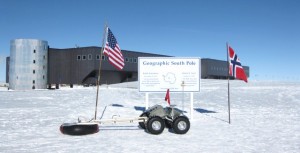 A four-wheeled robot cart is driving around Antarctica helping scientists study ice by avoiding crevasse dangers. Dubbed Yeti, the robot uses GPS and can map an area to inform researchers where the cracks and crevasses are located. Wonder if Yeti could detect the Atlas Fracture?
A four-wheeled robot cart is driving around Antarctica helping scientists study ice by avoiding crevasse dangers. Dubbed Yeti, the robot uses GPS and can map an area to inform researchers where the cracks and crevasses are located. Wonder if Yeti could detect the Atlas Fracture?
Dr. Crandee and Dr. Nouri certainly would have liked to have a Yeti robot while the terrorist team was descending the crevasse-scared glacier onto the Ross Ice Shelf. Certainly Josmen probably wished they had one!
Mini-sub delves in subglacial lake
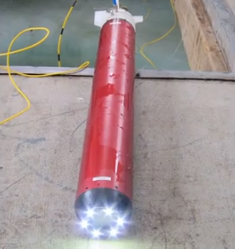 Researchers used a mini-sub to motor around the subglacial Lake Whillans. The sub was equipped with a video camera and a fiber optic link to the surface. One of the big issues involved in probing these subglacial lakes is trying to do it without contaminating the lake with microcrobes from the surface. So presumably that was an issue here. The video, however, makes no mention of efforts to sterilize the mini-sub. Maybe the scientists just skipped the whole idea as being too much of a problem(!). After all, they were way down in Antarctica, who would know?
Researchers used a mini-sub to motor around the subglacial Lake Whillans. The sub was equipped with a video camera and a fiber optic link to the surface. One of the big issues involved in probing these subglacial lakes is trying to do it without contaminating the lake with microcrobes from the surface. So presumably that was an issue here. The video, however, makes no mention of efforts to sterilize the mini-sub. Maybe the scientists just skipped the whole idea as being too much of a problem(!). After all, they were way down in Antarctica, who would know?
Subglacial lake has confirmed life – Is Atlas Fracture scenario real?
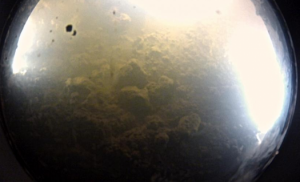 Scientists of the WISSARD expedition to drill into the subglacial Lake Whillans in Antarctica have now confirmed that early tests show there is biological life — bacteria and other microbes — living in the lake far under the Antarctic ice sheet. Further testing is required to determine what the microbes are and if they could pose a threat to those organisms living on the surface(!).
Scientists of the WISSARD expedition to drill into the subglacial Lake Whillans in Antarctica have now confirmed that early tests show there is biological life — bacteria and other microbes — living in the lake far under the Antarctic ice sheet. Further testing is required to determine what the microbes are and if they could pose a threat to those organisms living on the surface(!).
Seems like some of the scariest elements of my upcoming thriller The Atlas Fracture are proving alarmingly possible!
Image courtesy Dr. Alberto Behar, JPL/ASU
It all begins: subglacial life brought to surface
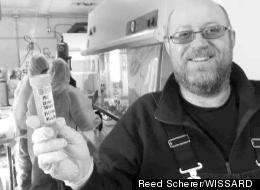 According to a story on Huffington Post, the Lake Whillans expedition may have broken the seal on unknown nasties: “Scientists have the first hints of life from a lake long trapped beneath tons of Antarctic ice.”
According to a story on Huffington Post, the Lake Whillans expedition may have broken the seal on unknown nasties: “Scientists have the first hints of life from a lake long trapped beneath tons of Antarctic ice.”
After drilling into the lake below the Antarctic ice, the American Lake Whillans scientists have brought up tiny cells and…… those cells respond to DNA-sensitive dye. This could be it, folks. That flu shot you got won’t help you now!
Read more about what could happen with these little subglacial beasties in my upcoming thriller, The Atlas Fracture.
Just keep saying to yourself, “it’s only a thriller novel, it’s only a thriller novel.”
The Real Science Behind The Atlas Fracture
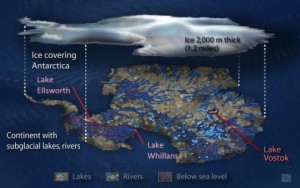 A recent article in the New York Times Science section described an American expedition to drill into a lake beneath the Antarctic ice cap. This effort neatly parallels the effort by the character Dr. Taylor Crandee in my novel The Atlas Fracture to drill into a subglacial lake called Lake Donatella. By the way, I promise the real-life Antarctic lake drilling effort is not a publicity stunt to promote my book (although the timing is excellent!).
A recent article in the New York Times Science section described an American expedition to drill into a lake beneath the Antarctic ice cap. This effort neatly parallels the effort by the character Dr. Taylor Crandee in my novel The Atlas Fracture to drill into a subglacial lake called Lake Donatella. By the way, I promise the real-life Antarctic lake drilling effort is not a publicity stunt to promote my book (although the timing is excellent!).
The actual expedition is called the Whillans Ice Stream Subglacial Access Research Drilling (WISSARD) project. It will drill down into Lake Whillans, a body of liquid water a half a mile below the surface of the Antarctic ice. The plan is to bring up water samples and analyze then on the spot for signs of microbial life. There could be strange, unusual and even dangerous forms of bacteria, viruses and who knows what else.
 The WISSARD expedition had to travel more than 625 miles across the Ross Ice Shelf to reach the location of the subglacial lake. Drilling through ice requires some gear, so more than 13 Sno-cats and tractors were used to haul equipment and to the site.
The WISSARD expedition had to travel more than 625 miles across the Ross Ice Shelf to reach the location of the subglacial lake. Drilling through ice requires some gear, so more than 13 Sno-cats and tractors were used to haul equipment and to the site.
In The Atlas Fracture, Dr. Crandee and his team use a similar hot water drill to melt their way into a lake located at the edge of the TransAntarctic Mountains. Dr. Crandee is convinced that volcanic heat from the mountains is providing a perfect environment for exotic microbial life. When he and his team succeed in bringing samples of this biologically rich water to the surface, the results are not what most in the team expect, however, and the effects felt all the way to Washington, D.C.
Watch for The Atlas Fracture, the next installment in the Perry Helion thriller series, available soon.
Apophis misses — this time
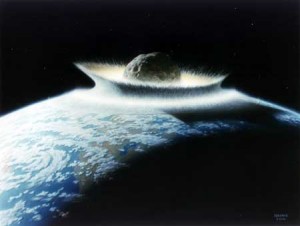 The asteroid Apophis, named after the Egyptian demonic serpent-spirit of destruction, swung by the earth on Jan. 9 — only 9 million miles from our planet’s surface. The potentially deadly object is scheduled to return twice in the next few decades. In 2029, the rough 300-yard-wide rockpile should pass within 23,000 miles. In 2036 Apophis could live up to its name and strike the earth. Would that be bad?
The asteroid Apophis, named after the Egyptian demonic serpent-spirit of destruction, swung by the earth on Jan. 9 — only 9 million miles from our planet’s surface. The potentially deadly object is scheduled to return twice in the next few decades. In 2029, the rough 300-yard-wide rockpile should pass within 23,000 miles. In 2036 Apophis could live up to its name and strike the earth. Would that be bad?
In 1961 the Soviet Union detonated the largest thermonuclear bomb ever: 57 megatons (or 57 million tons of TNT). The 1883 volcanic eruption of Krakatoa was equivalent to 200 megatons. Apophis hitting the earth would be roughly equal to a force of 500 megatons. That would be really bad.
But for now, we’ve dodged the demonic serpent-spirit of destruction bullet. And we can all go back to our thriller novels (like my book The SHIVA Compression!) and our apocalyptic movies. Because it’s always way better to read about a 500 megaton explosion in a book than to get one up in your grille in real life. If that were to happen in 2036, you think the sales of thriller novels might slack off a bit?

